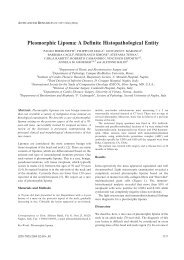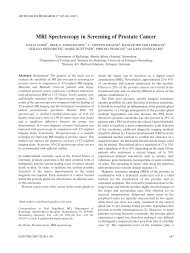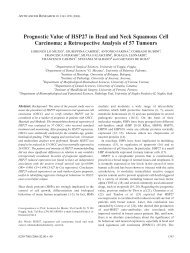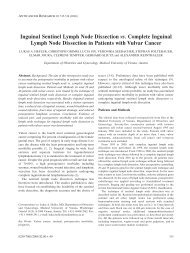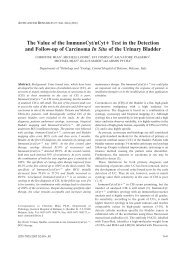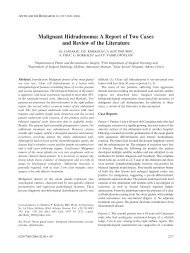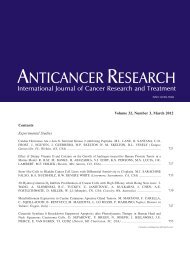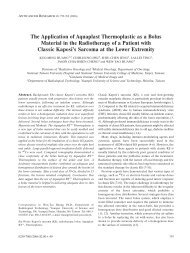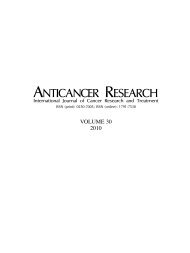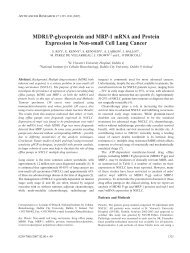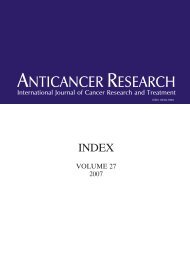ABSTRACTS OF THE 21st ANNUAL MEETING OF THE ITALIAN ...
ABSTRACTS OF THE 21st ANNUAL MEETING OF THE ITALIAN ...
ABSTRACTS OF THE 21st ANNUAL MEETING OF THE ITALIAN ...
You also want an ePaper? Increase the reach of your titles
YUMPU automatically turns print PDFs into web optimized ePapers that Google loves.
Table I.<br />
Minor surgical complications were observed in 12 patients<br />
(18%), including seven lymphoceles (10%), two pelvic<br />
hematomas (3%) and three bladder neck strictures (6%). The<br />
mean hospital stay was 5 (range 4-8) days. At last follow-up,<br />
all patients were alive. Discussion and Conclusion: IORT<br />
during RP represents a safe procedure, with acceptable<br />
surgical time and minimal toxicity for patients with locally<br />
advanced PCa. A larger series and a longer follow-up are<br />
needed to confirm these findings and to assess long-term sideeffects<br />
and biochemical control.<br />
181<br />
MALIGNANT HISTIOCYTOMA <strong>OF</strong> <strong>THE</strong> PENIS:<br />
A CASE REPORT<br />
Fabio Neri, Francesco Berardinelli, Luca Cindolo,<br />
Fabiola Raffaella Tamburro and Luigi Schips<br />
UOC Urologia, Ospedale San Pio San da Pietrelcina, Vasto<br />
(CH), Italy<br />
Background: Penile malignant fibrous histiocytoma is an<br />
extremely rare tumor, with only 5% of penile tumors being<br />
mesenchymal tumors. We present here a four-year follow-up<br />
of a patient affected by primary malignant fibrous<br />
histiocytoma of the penis. To the best of our knowledge, this is<br />
the first published report of such a case. Case Report: An<br />
uncircumcised 64-year-old male presented in April 2007 with<br />
a 4-cm solid lesion on the penile right base (Corporum<br />
cavernosum). There was no history of sexually transmitted<br />
disease, constitutional symptoms or dysuria. Physical<br />
examination revealed the absence of palpable abnormalities in<br />
the inguinal region. Inguinal ultrasound did not show any<br />
abnormal nodes. Penile needle biopsy revealed a malignant<br />
mesenchymal tumor. This case was treated surgically with<br />
total penectomy. Histopathological examination concluded the<br />
tumor was a G2 malignant histiocytoma, with negative<br />
surgical margins. Immunohistochemical stains were positive<br />
for vimentin and negative for cytokeratin, desmin, S-100,<br />
AE1/AE3, CK34, Be12, actin, desmin, CD31, CD34 and p63.<br />
Results and Conclusion: At the 4-year follow-up, the patient<br />
was in very good condition, without local or distant<br />
ANTICANCER RESEARCH 31: 1807-1956 (2011)<br />
% UTI Mild Severe Urethral Bladder AUR Recto-urinary<br />
incontinence I-II incontinence III stenosis neck strictures fistula<br />
All patients 14 21 3 7 10 8 1<br />
Group A 11 18 3 7 8 6 1<br />
Group B 3 3 0 0 2 2 0<br />
UTI: Urinary tract infection; AUR: acute urinary retention.<br />
1908<br />
metastasis, and with normal uroflowmetry is normal He has,<br />
however, developed a depressive syndrome mainly related to<br />
the absence of a penis. Malignant fibrous histiocytoma is<br />
rarely reported in the literature and primary involvement of the<br />
genitourinary tract is very rare. Because of the rarity of such<br />
tumors, there is no agreement concerning the best method for<br />
staging and management of these patients.<br />
1 Parsons MA and Fox M: Malignant fibrous histiocytoma of<br />
the penis. Eur Urol 14: 75-76, 1988.<br />
2 Moran CA and Kaneko M: Malignant fibrous histiocytoma<br />
of the glans penis. Am J Dermatopathol 12: 182-187, 1990.<br />
3 Tripathi VNP and Dick VS: Primary sarcoma of the urogenital<br />
system in adults. J Urol 101: 898-904, 1969.<br />
4 Zaffagnini V: Il sarcoma del pene. Contributo anatomoclinico<br />
e sintesi bibliografica. Arch Ital Anat Istol Pat 37:<br />
322-339, 1963.<br />
182<br />
CAN SPLITTING TURP AND<br />
HIFU INTO TWO SESSIONS<br />
REDUCE COMPLICATION RATES?<br />
Roberto Sanseverino, Olivier Intilla, Giorgio Napodano,<br />
Umberto Di Mauro and Tommaso Realfonso<br />
U.O.C. Urologia, Ospedale Umberto I, ASL Salerno, Nocera<br />
Inferiore, Salerno, Italy<br />
Aim: To evaluate whether splitting transurethral resection of<br />
the prostate (TURP) and high-intensity focused ultrasound<br />
(HIFU) into two sessions can reduce complication rates in<br />
patients with localized prostate cancer. Patients and<br />
Methods: From November 2004 to September 2010, 103<br />
patients affected by localized prostate cancer underwent<br />
HIFU following TURP. In 39 patients, both procedures were<br />
performed in the same session (Group A); in 64 patients,<br />
HIFU was delayed (Group B). Follow-up included serial<br />
PSA measurements and prostate biopsies 6 months after<br />
treatment for all patients. Biochemical recurrence was<br />
defined as PSA nadir + 2 ng/ml (ASTRO 2005 criteria). We<br />
evaluated complication rates in Groups A and B. Results:



